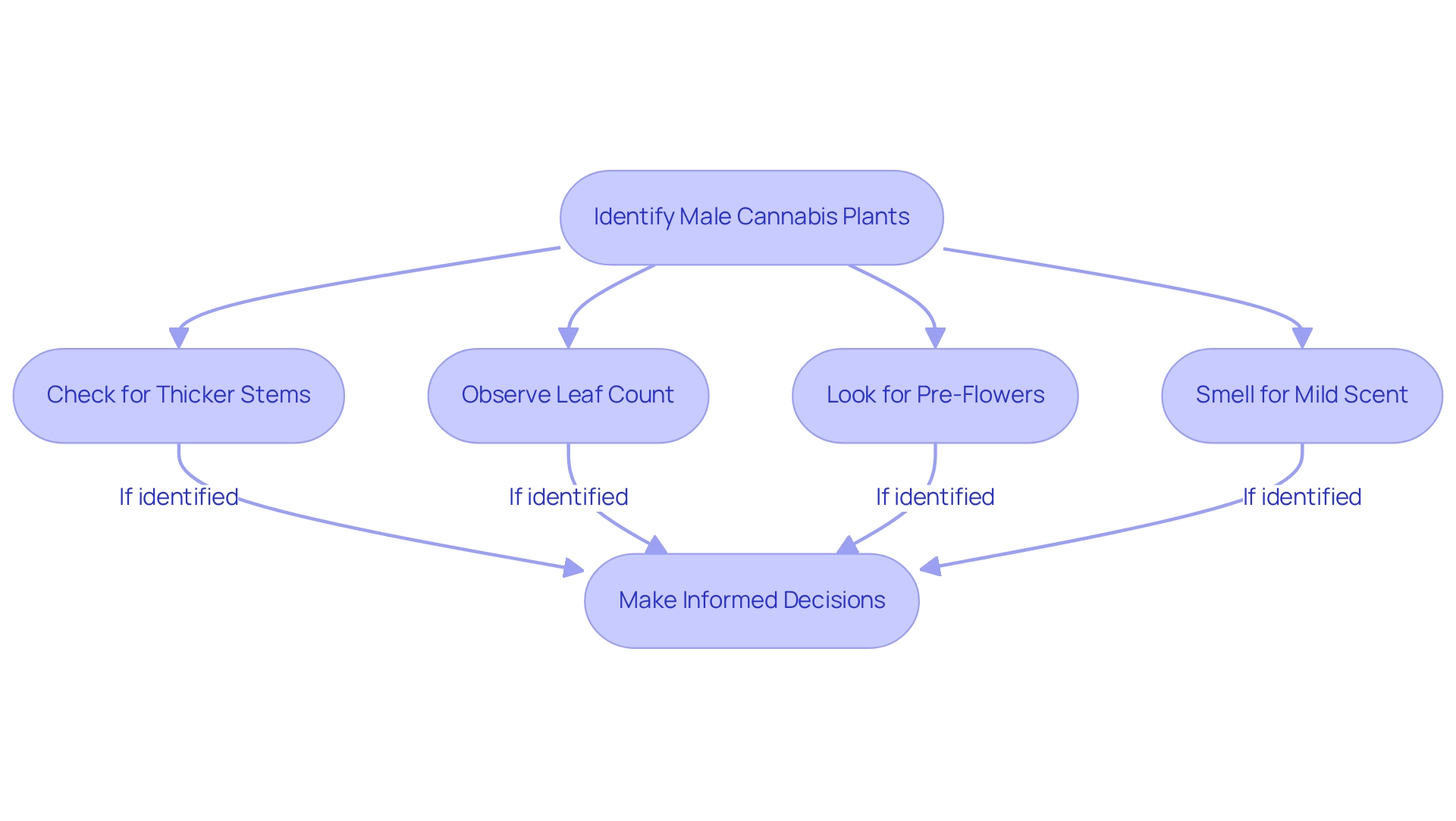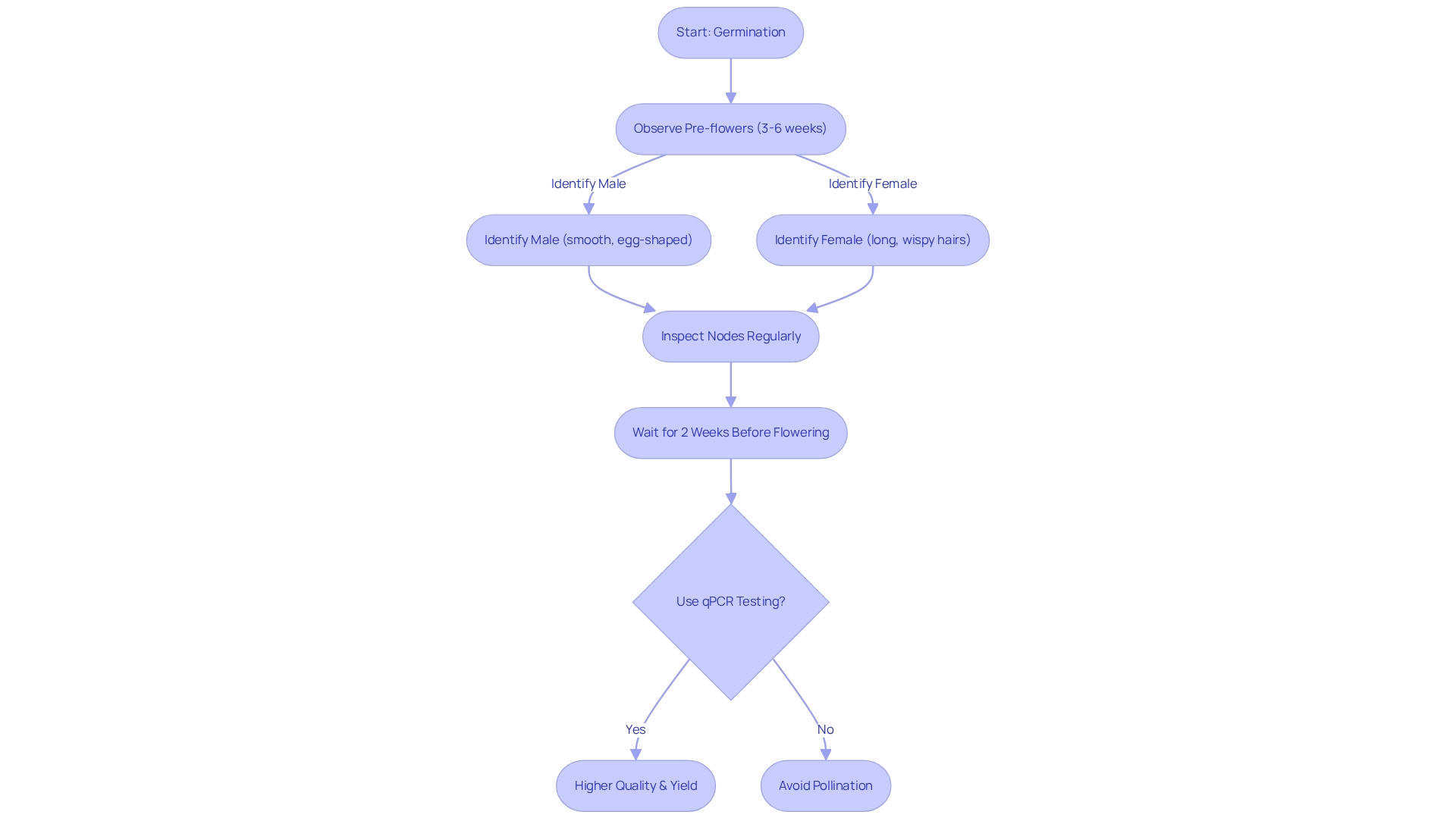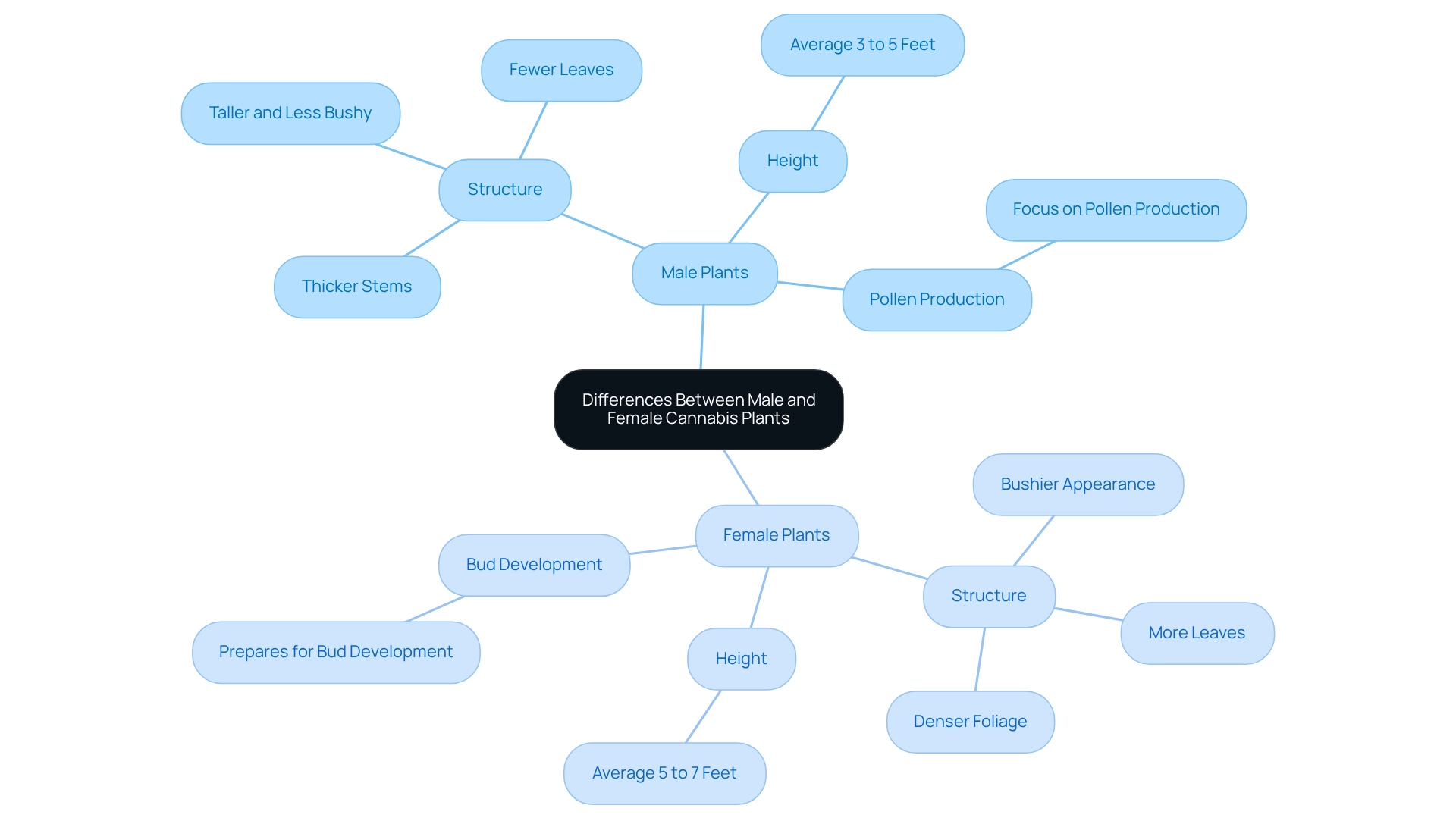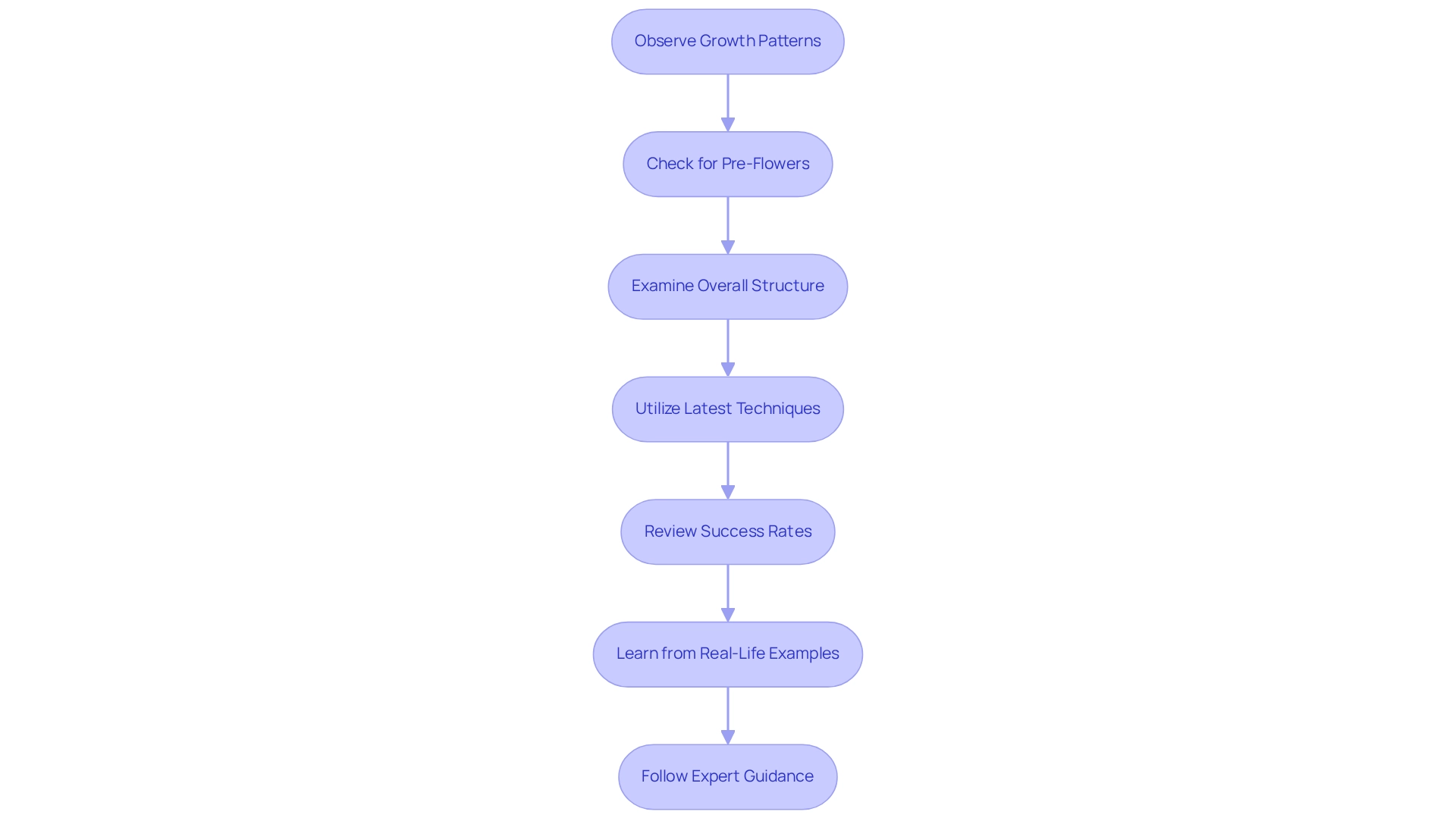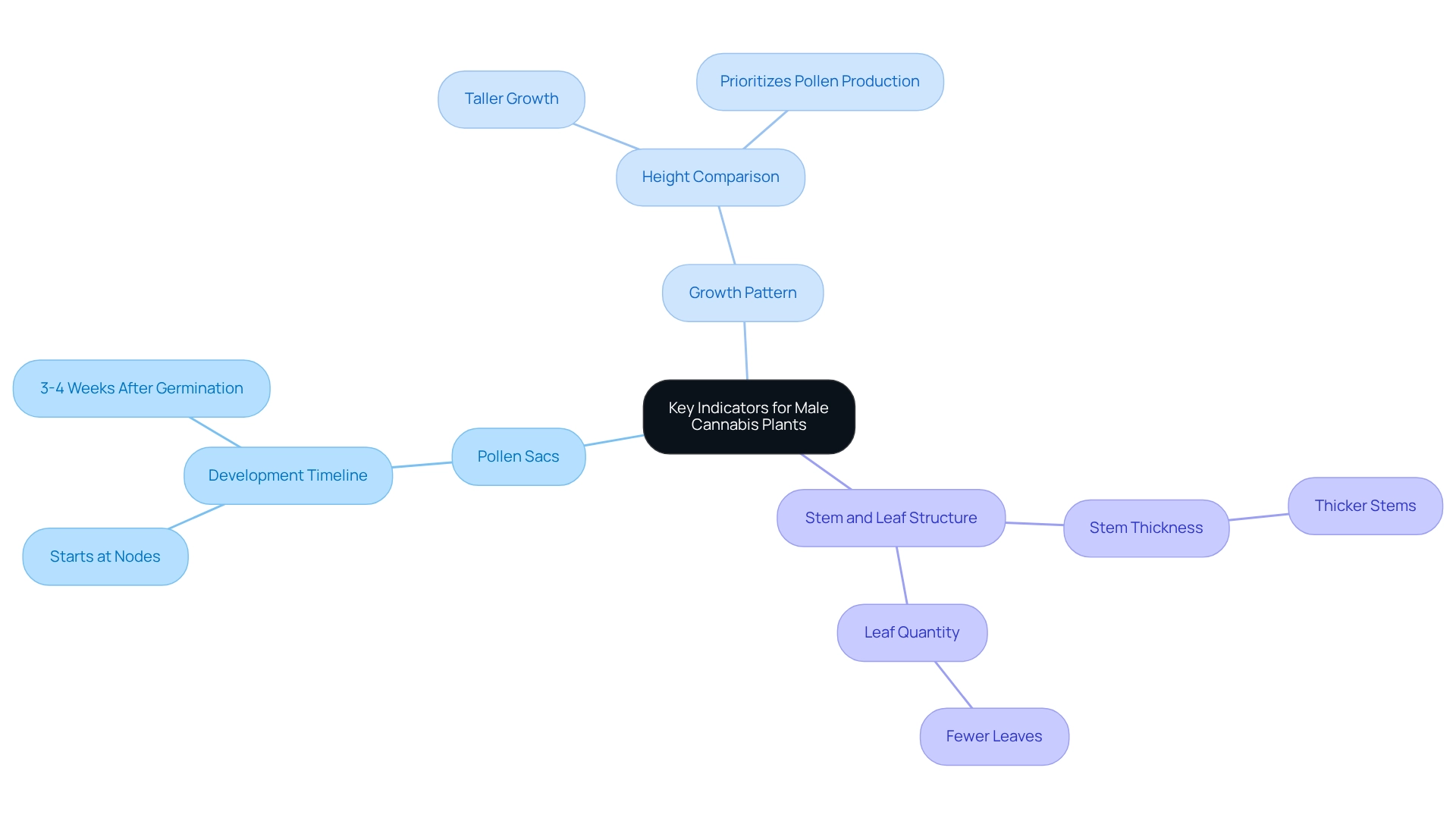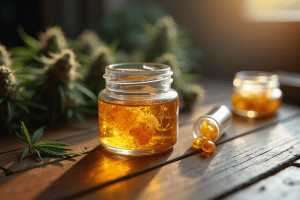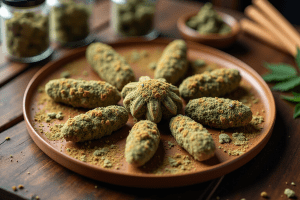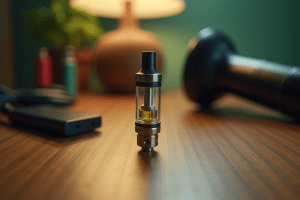Overview
The main question we explore together is how to identify the early signs of male cannabis plants. Recognizing these signs, such as pre-flowers and unique growth patterns, is crucial for cultivators like you. By understanding these indicators, we can help prevent unwanted pollination and optimize your yields. This not only enhances the quality of your harvest but also supports your journey as a cultivator.
Let’s navigate this process together, ensuring that your efforts lead to the best possible outcomes.
Introduction
Navigating the world of cannabis cultivation can feel overwhelming, especially when it comes to identifying male plants early in their growth cycle. With a 50/50 chance of seeds developing into either male or female plants, recognizing the signs of male plants is not just beneficial—it’s essential for optimizing yields and ensuring a successful harvest.
Have you ever felt uncertain about your plants? You’re not alone. This article explores the various characteristics that distinguish male cannabis plants from their female counterparts, offering practical tips and expert insights to empower growers at every level.
From understanding growth patterns and pre-flower development to leveraging advanced identification techniques, we aim to equip you with the knowledge needed to enhance your practices and make informed decisions in the ever-evolving cannabis landscape.
Together, we can navigate these challenges and cultivate success.
Leafy Mate: Your Guide to Identifying Early Signs of Male Cannabis Plants
Leafy Mate is an essential resource for marijuana cultivators, offering personalized suggestions and a wealth of information to help you identify male specimens early in their growth phase. Did you know there’s a 50/50 chance of seeds developing into male or female plants? Recognizing the early signs of male plant specimens is crucial for optimizing your yields. This statistic highlights the importance of early identification, as it directly influences your success in cultivation.
By utilizing Leafy Mate, you gain access to comprehensive guides and expert insights that simplify the process of determining the sex of marijuana species. This empowers you to make informed decisions, ultimately enhancing your cultivation success.
But Leafy Mate is more than just practical resources; it nurtures a community of engaged users, specifically designed to assist new marijuana consumers on their cultivation journey. Recent studies emphasize the importance of recognizing the early signs of male plant, as they can enhance genetic diversity in breeding initiatives and have practical uses in fiber production and cannabinoid extraction. These benefits can be advantageous for cultivators looking to diversify their yield.
Leafy Mate’s commitment to education ensures that both novice and experienced growers can navigate the complexities of plant cultivation effectively. Together, we promote responsible practices and informed decision-making. With 24/7 customer support, a vast network of dispensary listings, and a 100% money-back guarantee, Leafy Mate stands out as your reliable partner in this industry.
Furthermore, with over 10,000 dispensary listings and access to more than 100 in-network doctors, Leafy Mate is prepared to fulfill all your marijuana needs. As marijuana expert Drew Cano wisely advises, “Save time and grow better!” Learn how to choose and install the perfect auto watering system. This emphasizes the value of informed choices in successful cultivation.
For more information or to explore our services, contact us today! Together, we can cultivate success.
Crop King Seeds: Recognizing Male Cannabis Plants in the Vegetative Stage
During the vegetative phase, the early signs of male plant cannabis specimens exhibit unique traits that set them apart from females. Typically, they have thicker stems and fewer leaves, which can serve as crucial visual indicators for cultivators. Have you ever noticed these differences? One of the most definitive early signs of male plant is the formation of small, ball-like clusters known as pre-flowers at the nodes. Recognizing the early signs of male plant pre-flowers is essential for determining the organism’s gender, which allows growers to make informed choices about their cultivation strategies.
Research shows that identifying these traits early can significantly impact crop management. For instance, utilizing male botanical material as mulch not only helps preserve soil structure but also enhances fertility. This highlights the potential advantages of these specimens in cultivation. Leafy Mate’s user manuals on effective growing methods emphasize this practice, providing guidance for both novice and seasoned users who wish to improve their cultivation experiences.
Moreover, the scent of male marijuana species is typically milder and less complex due to reduced terpene levels, which can assist in their identification. Specialists in horticulture underscore the importance of closely observing vegetation during this stage. As industry expert Theo Gardner notes, “Instead of viewing these specimens merely as a threat to harvest output, they can be seen as valuable assets that create new opportunities for innovation in cultivation.”
By understanding the early signs of male plant, we can effectively manage our crops and optimize yields together. A practical suggestion for new marijuana users is to regularly check their plants for the early signs of male plant. This practice will help you recognize the early signs of male plant specimens and make informed choices regarding your cultivation methods. Furthermore, staying informed about marijuana legalization and the 2025 policy reform legislation can empower you to navigate the evolving landscape of cultivation and usage.
Grow Weed Easy: How to Determine the Sex of Your Cannabis Plants
To determine the gender of cannabis crops, we should gently observe the early signs of male plants in the characteristics of pre-flowers, which typically appear between three to six weeks after germination. Male pre-flowers are small and smooth, with an egg-shaped form that resembles tiny pollen sacs. In contrast, female pre-flowers develop distinct long, wispy hairs, which are essential for identifying the plant’s sex. Regularly inspecting the nodes—where the leaves meet the stem—is vital for spotting these early signs.
Once established, cuttings may need around two weeks before transitioning to flowering, allowing us to confirm the gender of our specimens. It’s important to understand that while male specimens won’t release their pollen until four to five weeks after blooming, we might inadvertently allow some pollen to escape when removing the males. Many commercial producers have turned to advanced methods, such as qPCR testing, to effectively determine the sex of crops and other genetic characteristics internally. This approach greatly enhances operational efficiency and yield management.
Investing in technology not only ensures higher quality and yield but also empowers us to make informed decisions early in the cultivation process. Identifying the early signs of male plant specimens is crucial, as it helps prevent unwanted pollination and maximizes the quality of our harvest. Together, let’s embrace these practices to nurture our plants and enhance our growing experience.
Medic Grow LED: Understanding Differences Between Male and Female Cannabis Plants
Male cannabis specimens typically exhibit a taller and less bushy structure compared to their female counterparts. They have thicker stems and fewer leaves, allowing them to focus their energy on pollen production. In contrast, female specimens are characterized by a bushier appearance, featuring more leaves and denser foliage as they prepare for bud development. Recognizing the early signs of male plant is crucial for cultivators. This awareness empowers you to make informed decisions about vegetation management.
Key Differences to Note:
- Structure: Male specimens are taller with fewer leaves; female specimens are bushier with more foliage.
- Height: Male specimens average 3 to 5 feet, while female specimens can reach 5 to 7 feet, depending on the strain and growing conditions.
Statistics indicate that the total time from the onset of flowering until pollen is released generally spans about 6 to 8 weeks under optimal conditions. This timeline underscores the importance of identifying the early signs of male plant. By recognizing these signs, you can better plan your cultivation strategies.
To optimize yields and ensure a successful harvest, it’s essential to regularly monitor your plants for signs of stress or environmental changes. Understanding the nuances of marijuana cultivation is vital for new consumers. Have you considered consulting with knowledgeable sources? They can provide valuable insights into effective practices. By being aware of the early signs of male plant and growth patterns, you can mitigate risks and enhance your cultivation success. Together, we can navigate this journey with confidence.
Blimburn Seeds: Step-by-Step Guide to Identifying Male Cannabis Plants
Recognizing cannabis specimens of the male gender is essential for cultivators who want to enhance their yields. Let’s explore a step-by-step guide to help you confidently differentiate male specimens from females:
- Observe Growth Patterns: Have you noticed that male specimens generally grow taller and faster than their female counterparts? This characteristic can serve as an early indicator, highlighting the early signs of male plant.
- Check for Pre-Flowers: At the nodes, look for small, round pollen sacs—these are the pre-flowers of male specimens. They are unique and can often be observed before the plants fully mature.
- Examine Overall Structure: Male cannabis plants typically have thicker stems and fewer leaves than females. This structural difference can assist in early identification.
- Utilize Latest Techniques: Recent advancements in cultivation methods, including specific surfactants and adjuvants, can significantly enhance flower stimulation, aiding in the identification process. Research shows that these methods can improve the accuracy of detecting early signs of male plants.
- Review Success Rates: Growers who embrace these identification techniques often report greater success in identifying early signs of male plant genders, which is crucial for avoiding unwanted pollination. A study involving a validation set of 20 samples tested with the SexID qPCR assay supports the effectiveness of these scientific approaches.
- Learn from Real-Life Examples: Many seasoned cultivators generously share their insights on identifying male varieties, highlighting the importance of attentive observation and understanding growth stages.
- Follow Expert Guidance: Engaging with cultivation specialists, like those from the Mountain Crop Improvement Lab, can offer you valuable tips for effectively identifying male marijuana varieties. As Nathan Lynch noted, collaborating with specialists enhances our understanding of plant identification.
By following these supportive guidelines, you can confidently recognize the male variety of marijuana, leading to a more fruitful growing experience. Remember, clear communication and informed decision-making are vital in the cannabis industry, as highlighted by studies on the impact of mandatory warning signs in dispensaries.
WikiHow: Practical Steps to Identify Male and Female Marijuana Plants
Recognizing the early signs of male plant genders in cannabis species is essential for successful farming, and we understand that identifying these signs can be a challenging task. Here are some practical steps to help you distinguish between the two:
- Examine the Stalks: Male specimens typically have thicker, sturdier stalks with fewer leaves compared to their female counterparts.
- Look for Early Signs of Male Plant: At the nodes, distinct pollen sacs develop in masculine specimens, which are crucial indicators of their sex.
- Evaluate Growth Patterns: Generally, male specimens grow taller and are less bushy than females, making them easier to identify.
Routine evaluations are vital. Cultivators who consistently observe their crops often report greater success in recognizing the early signs of male plant. For instance, a case study highlighted that allowing male specimens to pollinate females can significantly decrease THC levels in the harvest. This underscores the importance of early identification of early signs of male plant. As D. Sutton wisely notes, “Observing your greenery closely can spare you from a disappointing yield later on.”
Furthermore, it’s important to nurture your plants under suitable conditions. Initially, they should be cared for under a 24-hour photoperiod for four weeks before transitioning to a 12-14 hour dark:10-12 hour light schedule. By following these steps together, we can ensure a more fruitful and potent yield.
Reef Fertilizer: Key Indicators for Male Cannabis Plants
Key indicators of cannabis specimens are essential for cultivators who want to maximize yield and quality. By identifying the early signs of male plant early, you can prevent unwanted pollination and ensure that female specimens produce seedless, cannabinoid-rich buds. Here are the primary indicators to watch for:
- Pollen Sacs: Small, round pollen sacs start to develop at the nodes about three to four weeks after germination. These sacs clearly indicate the early signs of male plant specimens.
- Growth Pattern: The early signs of male plant specimens typically exhibit a taller growth pattern compared to females, as they prioritize spreading pollen over producing flowers.
- Stem and Leaf Structure: Males often have thicker stems and fewer leaves, contributing to their sturdiness and ability to support pollen production.
Understanding the early signs of male plant characteristics is crucial. Identifying the early signs of male plant can significantly impact the quality of your harvest. For example, studies show that the early signs of male plant detection can lead to greater yields of quality buds, allowing you to focus your resources on female plants. As a cultivation specialist notes, “If the DNA sample contains a Y chromosome, a chemical reaction will turn the pink solution yellow, indicating a positive result.”
In 2025, more cultivators are utilizing these indicators to enhance their farming strategies, helping them navigate the complexities of gardening effectively. With the marijuana sector expanding rapidly, understanding these signs becomes increasingly important for new cultivators who wish to seize profitable opportunities. Together, let’s explore these indicators and cultivate a successful garden.
Medicinal Genomics: Benefits of Early Sex Identification in Cannabis Plants
Recognizing the early signs of male plant cannabis types offers many benefits for cultivators, and we want to ensure you feel supported in this process.
Quality Assurance: By eliminating male specimens before they can fertilize female ones, you can guarantee the creation of superior quality buds. Pollination can lead to lower cannabinoid concentrations and undesirable seed formation, diminishing the overall value of your harvest.
Resource Optimization: Early sex identification allows you to allocate your space and resources more effectively. By concentrating on female specimens, which are the main source of desired yields, you can enhance your output and efficiency.
Seed Prevention: Identifying male specimens quickly decreases the chance of unwanted seeds in your final product. This is crucial, as a single hermaphroditic organism can pollinate an entire crop, jeopardizing the quality of your yield. Recent research highlights the importance of recognizing the early signs of male plant in marijuana cultivation. Experts note that proactive measures can significantly enhance crop quality. For example, understanding the effects of masculine specimens can lead to improved management techniques, as demonstrated in case studies where cultivators effectively maximized their yields by recognizing early signs of male plants and eliminating them early in the growth phase.
Moreover, male marijuana specimens play a crucial role in breeding initiatives, aiding in the creation of varieties with distinct cannabinoid profiles, flavors, and scents. As Leafy Mate highlights, through managed pollination, male specimens help create the genetic variety crucial for producing high-quality marijuana items. Furthermore, growers are increasingly employing male marijuana specimens to produce concentrates, hash, edibles, juices, and hemp roots, showcasing their versatility beyond reproduction.
For those seeking additional advice on cultivating their marijuana crops, connecting with growing specialists can offer valuable insights and assistance. Together, we can ensure that your early recognition of male marijuana specimens not only protects the quality of your harvest but also empowers you to make informed choices that enhance your farming techniques.
The Cannabis Grow Bible: Dealing with Male Cannabis Plants
When cultivators recognize the early signs of male plant cannabis specimens, several thoughtful actions can enhance their cultivation efforts:
- Remove Male Specimens: One of the most common strategies is to remove male specimens from the cultivation space. This step is crucial as it prevents the pollination of female plants, which is essential for optimizing the yield of high-quality buds.
- Breeding Opportunities: If breeding is part of your goals, consider preserving male specimens for cross-pollination with selected female strains. This can enhance genetic diversity and potentially introduce new, desirable traits in future crops.
- Utilization for Composting: Additionally, male specimens can be repurposed for composting or other applications, contributing organic matter back into the cultivation process. This approach minimizes waste while enriching the soil for future crops, and identifying the early signs of male plant specimens is vital for achieving the best results in cultivation. A recent survey revealed that 21% of Americans aged 18-64 prefer flowers, highlighting the importance of producing high-quality female specimens to meet consumer demand. In competitive markets like Oklahoma, where there are 36 dispensaries for every 100,000 residents, the need for quality female plants becomes even more pressing.
Furthermore, educational resources on marijuana cultivation are increasingly accessible. These resources empower cultivators with the knowledge needed to make informed decisions. Understanding the broader implications of marijuana cultivation, especially in light of recent policy reforms, is essential for responsible practices. Information on the effectiveness of marijuana training programs shows that knowledgeable cultivators are better prepared to manage their crops successfully. As Margaret E. Mattson, chairperson of the Alcohol and Other Drug Abuse Advisory Council, emphasizes, this knowledge is crucial for navigating the evolving landscape of marijuana legislation and cultivation. By understanding the early signs of male plant specimens, producers can enhance their overall marijuana production strategy. To implement this information, consider developing a plan that includes consistent oversight of your plants and utilizing educational materials to stay informed about the best cultivation methods. Together, we can cultivate a thriving environment for all.
Cannabis Training University: Educational Resources for Identifying Male Cannabis Plants
At Leafy Mate, we understand the journey of cultivators who are eager to recognize male marijuana varieties. Our extensive selection of educational materials is designed with you in mind. These resources include:
- Detailed guides to help you distinguish between species
- Interactive video tutorials that walk you through the identification process
- Expert insights offering practical tips for successful cultivation
Notably, our ‘Sexing Cannabis Plants’ course focuses on identifying the early signs of male plant traits when differentiating between male and female plants, ensuring that you can make informed choices in your growing methods. As the marijuana industry continues to flourish, with sales projected to reach $87.0 billion by 2035, the importance of well-informed growers has never been more critical. This growth underscores the need for education in cultivation methods, especially as more individuals enter the market with the goal of growing marijuana responsibly. Educational platforms like Leafy Mate play a vital role in equipping you with the skills needed to navigate this evolving landscape.
Have you noticed the recent trends in user engagement with cultivation resources? There’s a remarkable rise in interest in responsible and informed growing practices. For example, data shows that enrollment in marijuana training programs has surged by over 30% in the past year, reflecting our community’s commitment to enhancing cultivation skills.
Furthermore, the recent case study from Slovenia, where voters approved measures for home cultivation of marijuana plants, illustrates the real-world implications of marijuana education. This decision not only signifies a broader acceptance of marijuana cultivation but also highlights the necessity for educational resources to support new cultivators in understanding best practices. With the right training, you can enhance your identification skills, ensuring a successful and fruitful harvest.
If you’re eager to expand your knowledge and skills in cannabis cultivation, we warmly invite you to explore Leafy Mate’s offerings. Together, we can embark on this educational journey. For more information or to get started, please feel free to contact us at [email protected] or call +833-245-3239.
Conclusion
Understanding the early identification of male cannabis plants is crucial for successful cultivation. This article has highlighted the key characteristics that differentiate male plants from females, emphasizing the importance of recognizing these signs early in the growth cycle. By observing the distinct structure, growth patterns, and the development of pre-flowers, growers can implement practical tips and advanced techniques to optimize their yields.
By leveraging resources like Leafy Mate and other educational platforms, cultivators can enhance their knowledge and skills. This empowerment allows them to make informed decisions that ultimately lead to higher quality harvests. Proactively identifying male plants not only safeguards the quality of female buds but also promotes efficient resource allocation and effective crop management.
As the cannabis industry continues to evolve, the demand for educated growers is greater than ever. Embracing the insights shared in this article can empower individuals at all levels of cultivation. This paves the way for a successful and sustainable cannabis-growing journey. Recognizing the value of early sex identification is an essential step toward mastering the art of cannabis cultivation and achieving optimal results. Together, let’s embark on this journey and cultivate our knowledge for a thriving future.
Frequently Asked Questions
What is Leafy Mate and how does it assist marijuana cultivators?
Leafy Mate is a resource for marijuana cultivators that offers personalized suggestions and extensive information to help identify male plants early in their growth phase, which is crucial for optimizing yields.
Why is early identification of male plants important in marijuana cultivation?
Early identification of male plants is important because there is a 50/50 chance of seeds developing into male or female plants. Recognizing male specimens early influences cultivation success and helps optimize yields.
What type of resources does Leafy Mate provide to users?
Leafy Mate provides comprehensive guides, expert insights, user manuals, and a supportive community to help both novice and experienced growers navigate plant cultivation effectively.
How can recognizing male plants benefit marijuana cultivators?
Recognizing male plants can enhance genetic diversity in breeding initiatives and has practical uses in fiber production and cannabinoid extraction, which can be advantageous for diversifying yields.
What traits help in identifying male cannabis plants during the vegetative phase?
Male cannabis plants typically exhibit thicker stems, fewer leaves, and the formation of small, ball-like clusters known as pre-flowers at the nodes, which are key visual indicators.
What are the characteristics of male and female pre-flowers?
Male pre-flowers are small, smooth, and egg-shaped, resembling tiny pollen sacs, while female pre-flowers have distinct long, wispy hairs that are essential for identifying the plant’s sex.
How can cultivators manage male plants effectively?
Cultivators can manage male plants by regularly inspecting their plants for early signs, using male botanical material as mulch to enhance soil fertility, and employing advanced methods like qPCR testing for accurate sex determination.
What support does Leafy Mate offer to its users?
Leafy Mate offers 24/7 customer support, a vast network of dispensary listings, and a 100% money-back guarantee, making it a reliable partner for marijuana cultivators.
How does Leafy Mate promote responsible cultivation practices?
Leafy Mate promotes responsible practices by providing educational resources, encouraging informed decision-making, and supporting users in understanding the complexities of plant cultivation.
What should new marijuana users do to enhance their cultivation success?
New marijuana users should regularly check their plants for early signs of male specimens and stay informed about marijuana legalization and policies to navigate the evolving landscape of cultivation.
Get Your Medical Card
Connect with a licensed physician online in minutes


